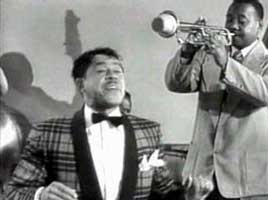 Rhythm & Blues Revue (1955) is a collection of Snader telescriptions filmed as individual musical shorts between 1950 & 1952, with some new music, an emcee, & comedy routines added, these these being Studio Telescriptions been filmed in 1954.
Rhythm & Blues Revue (1955) is a collection of Snader telescriptions filmed as individual musical shorts between 1950 & 1952, with some new music, an emcee, & comedy routines added, these these being Studio Telescriptions been filmed in 1954.
By inserting jump-cuts to an excited audience, editing in opening & closing curtains, & a bit of use of canned laughter & applause, the finished compilation is able to give the vague impression that this is a single night's concert of great black performers filmed at the Apollo Theater.
They are live recordings, but not at the Apollo. The performances from earlier in the '50s were originally made for syndication to television stations, to be used like vinyl records at a radio station, but on tv. The idea was to have the equivalent of a radio music program for the new visual medium of television.
The plan was a good one but for sundry reasons it fell apart, & the telescriptions ended up more often used as three-minute space-fillers whenever a program didn't quite fill out its half-hour or hour of time & not quite enough advertisements were sold.
As the Snader company was collapsing they sold their backlist of short films to their only rival, Studio Telescriptions, which became Studio Films, Inc. Their plan to imitate Snader's televised disc jockies notion had also petered out, but they had the bright idea of repackaging these short-short films in "sets" that would be arranged to look like concerts.
Many of them were syndicated in half-hour bites, segregated into sets with black artists & with white artists. The African American portion pretended to be live shows at the Apollo Theater in Harlem, with the overall series title Live at the Apollo & subtitles for each set. Two longer compilations were released as theatrical feature films, Rhythm & Blues Revue & the somewhat misnomered Rock & Roll Revue, both in 1955.
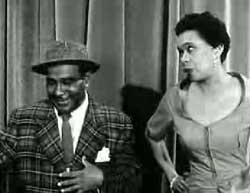 The emcee was "that clown prince of mirth" Willie Bryant, who was in fact the emcee at the Apollo in this era. The emcee was "that clown prince of mirth" Willie Bryant, who was in fact the emcee at the Apollo in this era.
He's awful as a stand-up comedian & as a host probably not as good as he was at the Apollo since here he's only pretending to have an audience & not generating feedback to keep himself going.
Willie's presence, however, underscored the illusion that these were films of actual Apollo Theater events rather than a hodgepodge of Snader & Studio telescriptions from the previous five years.
Rhythm & Blues Revue opens with a comedy routine between husband & wife comedy team "Freddie & Flo" together with Willie Bryant. Florence Hill does a comic mind-reading routine that gets Freddie Lucas in trouble for just thinking.
They will have additional routines inserted as the trumped up "concert" progresses. They do have a last-days-of-vaudeville charm. Their humor (from this period) pretty much relied on a very old stereotypical assumpton of the black man is a dishonest weasily semi-retarded fool & the black woman is smart, honest, & sensible.
But are they at least funny about it? I guess, though if they were ever great it was years before they appeared in this, & Freddie & Flo at their best never made it onto film. Even so, compared to Willie Bryant they're super. His most elaborate comedy routine will appear halfway through the film, in which he pulls a scam on an ignorant & distracted shop-owner. Trickster negro robs ignorantly hard working negro is just not funny stuff.
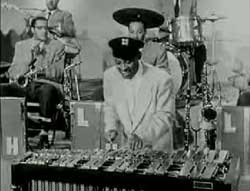 The first musical introduction is for a Snader telescription of Lionel Hampton & his band, with Lionel at the vibraphone, doing a boogie number Vibe Boogie (1951).
The first musical introduction is for a Snader telescription of Lionel Hampton & his band, with Lionel at the vibraphone, doing a boogie number Vibe Boogie (1951).
This is wonderfully entertaining even for someone like me who has never been a particular vibraphone fan.
Vibe Boogie is in circulation both as a separate Snader with its original title card, & intercolated into the present 1955 film with canned audience reactions edited in. In the latter, Willie Bryant introduces the number as it "a good old-fashioned jam session."
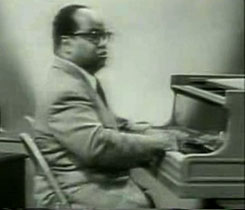 Hamp's practically soloing on vibrahone, with just the drum & slapbase backing him, with the orchestra otherwise just clapping hands. Hamp's practically soloing on vibrahone, with just the drum & slapbase backing him, with the orchestra otherwise just clapping hands.
Momentarily Milton Buckner joins in on piano & Hamp shouts, "And now we'll give you a little, a small jam session. Come on, Milt!"
It's not so much a jam session as it is a well arranged round of solos. Slap bass follows the piano solo, then electric guitar, then the whole band stands up adding a bank of saxophones then bank of slide trumbones to the arrangement.
With the whole band now backing him, Hamp is again fast upon the vibraphone, with a close-up of the drummer for a raucous final note.
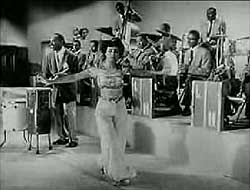 Lionel will be back later in the "concert" drumming in the exotica jazz number Bongo Interlude (1951) which is even more exciting than Vibe Boogie. Lionel will be back later in the "concert" drumming in the exotica jazz number Bongo Interlude (1951) which is even more exciting than Vibe Boogie.
Hampton dominates this telescription with a tomtom solo that's to die for. His eyes are flashing as though he's having the best time on earth.
There's a beautiful athletic woman at his side doing nothing but a standing-in-place rhumba for the longest while. When Lionel flirts with her without missing a beat, a laugh track has been put on the soundtrack to further phoney up the "live at the Apollo" affectation.
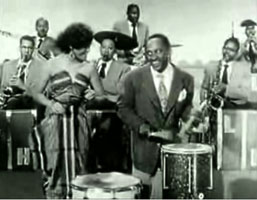 But there's another version of this telescription in circulation that retains the original 1951 title card & has no audience-reaction intrusions added. But there's another version of this telescription in circulation that retains the original 1951 title card & has no audience-reaction intrusions added.
A small organ solo from Milton Buckner leads into her dance, which is kind of a combination ballet & I Dream of Jeannie belly-dance & shimmy, quite sexy. If you know who this dancer is, please inform me!
The excellent trumpet solo by the guy in the attention-grabbing headgear is none other than Quincey Jones.
Throughout Hamp keeps pounding that tomtom, with now & then, visible in the far back of the orchestra (captured by the camera right over Hamp's shoulder) is Wilbur Hogan drumming like mad to increase the percussive intensity of Hamp's tomtom.
Bongo Interlude is one of the more refined & exciting Snader short subjects. See also the reviews of the rest of Lionel Hampton's telescriptions.
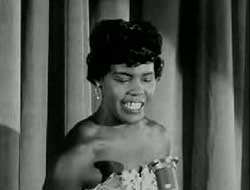 After Lionel's first number, there's brand new footage of a fine young singer, Faye Adams singing Every Day (1954). She made one other telescription, Somebody Somewhere (1954). After Lionel's first number, there's brand new footage of a fine young singer, Faye Adams singing Every Day (1954). She made one other telescription, Somebody Somewhere (1954).
"Every Day" was Faye's third single, released in 1954, & was the only one of her first four releases not to reach the R & B charts, who can say why since it's a fine number.
She had a huge voice though she was a small woman, & is a more thrillling singer than many that are better remembered from the era.
She expected to gain cross-over popularity but never did, possibly because she was a pure black beauty who exuded strength & was more threatening than the chubby singers white audiences could view as "mammy" types or the yaller beauties with thinner lips & narrow noses such as suited the aesthetics of white audiences.
Then again, perhaps it was only because rock 'n' roll's rise meant the best pure R & B artists weren't necessarily going to reach the biggest commercial heights, no matter how great. She struggled for about ten years to make it as a pop artist, then abandoned secular music to return to her gospel roots, & in later years refused even to talk about her R & B recordings, which didn't help keep her reputation alive.
Personally I felt Every Day did have cross-over appeal & should've been a rock ballad hit. Her deep vocal register conveyed an authoritative strength some might call masculine, & the performance reminds me just a bit of the later Lenny Welch cover of "Since I Fell for You." It is in any case one of the great portions of Rhythm & Blues & is truly to treasure.
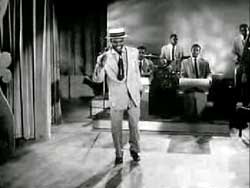 Next up is Bill Bailey tapping to a rather quiet instrumental version of the Larks' hit "The World is Waiting for Sunrise" performed by the Paul Williams Quartet.
Next up is Bill Bailey tapping to a rather quiet instrumental version of the Larks' hit "The World is Waiting for Sunrise" performed by the Paul Williams Quartet.
He's the brother of singer Pearl Bailey, but he has nothing to do with her signature song "Won't You Come Home Bill Bailey" which is a very old standard dating back to 1902.
Bill's frequently credited with "inventing" the "moonwalk" because of a tapdancing move called "backslide" which he does in this filmed performance.
Others credit the original moonwalk to Jean-Louis Barrault who did it during his pantomime performance in the classic Children of the Paradise (1945). But that performance was an idealized restatement of an act that dates at least to the 1860s in Parisian pantomime houses. Michael Jackson himself never claimed to have invented the moonwalk, but was taught the move by Cooley Jackson.
These antecedents to Jackson's signature move from the 1980s are debatable since the backward "slide dance" was around in the earliest 1930s at least, probably longer, & was often done by Cab Calloway.
Innovator, perhaps not, but Bill Bailey was a fine traditional tapper. As he comes on stage, he immediately mentions Bill Robinson, "my good friend," & performs a pure old-fashioned tap routine in Bojangles' honor. This is a lovely, simple, elegant performance, original to the film.
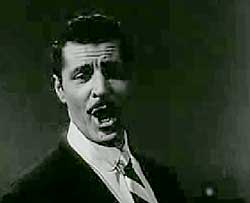 Bill's followed by a Snader telescription of Herb Jeffries, on a rooftop which has a cheap lead pipe railing leading down a staircase. This set will be seen in several of the earliest Snader telescriptions. Herb deliver's a crooner's performance with In My Heart (1950).
Bill's followed by a Snader telescription of Herb Jeffries, on a rooftop which has a cheap lead pipe railing leading down a staircase. This set will be seen in several of the earliest Snader telescriptions. Herb deliver's a crooner's performance with In My Heart (1950).
Multiracial Herb is more than commonly successful with his mellowed-out swing sound. He performed with Duke Ellington in the 1940s & introduced the number "Angel Eyes."
He also appeared in a handful of all-black cowboy pictures & became known as "the bronze buckeroo."
This song isn't one I care much for, nor is the crooner style a favorite of mine no matter who does it. But Herb's matinee idol good looks & slim self-assured baring makes it a nice little film even so.
Most of the older Snaders blended well with the 1954 film footage for matched lighting, but this one has a completely different lighting & is the most obviously spliced-in number.
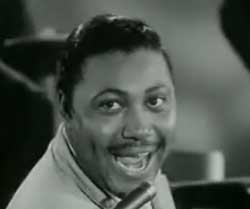 An original Studio Telescription performance of surprising glory is the jump-jazz or Texas boogie-woogie genius of Amos Milburne performing his 1950 classic Bad Bad Whiskey (1954). Milburn is a singer very much to my tastes, & all his other Studio telescriptions are reviewed on the Amos Milburn page.
An original Studio Telescription performance of surprising glory is the jump-jazz or Texas boogie-woogie genius of Amos Milburne performing his 1950 classic Bad Bad Whiskey (1954). Milburn is a singer very much to my tastes, & all his other Studio telescriptions are reviewed on the Amos Milburn page.
The extreme popularity of this one song so overshadowed his other achievements that to some he began to look like a one-hit-wonder, though not to those who paid attention to R & B charts.
Milburne had ups & though as an entertainer, instead of the continuous top success his talent merited.
He was destined to write or perform a number of jump-jazz drinking songs in order to live up to an expectation. To make a living, he was often stuck on an endless journey of one-night-stand performances, until his health gave out.
Sitting at the piano in his smart white suit, handsome as a devil, Amos is backed by the Paul Williams Band. His position as one of the formative pioneers in the development of rock 'n' roll is clear from this performance, which makes it all the more damnable that the rise of rock diminished the commercial success of jump-jazz artists like Amos Milburn or Louis Jordan, who contributed so much to that change in public taste.
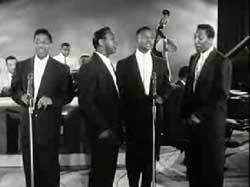 A Studio telescription of The Larks performing The World is Waiting for Sunrise (1954) has them striving toward doo-wop even though for this song at least, they are still under the influence of the Mills Brothers. Their telescriptions are collectively reviewed on The Larks page.
A Studio telescription of The Larks performing The World is Waiting for Sunrise (1954) has them striving toward doo-wop even though for this song at least, they are still under the influence of the Mills Brothers. Their telescriptions are collectively reviewed on The Larks page.
Except for Gene Mumford, The Larks that formed in 1954 were not the same group that had recorded under this name in 1951, & the new Larks weren't as innovative but were undoubtedly very, very fine singers.
They didn't last long enough to even find out if they could've been commercial successes. Rhythm & Blues Revue premiered in Baltimore in December 1955, more than a year after the filming of the newly inserted material, & by then The Larks had already broken up.
The name The Larks was in emulation of the The Orioles, The Cardinals, & The Ravens, which alone conveys the sort of group they wanted to be.
The name was a good enough one that other groups used it to, lending some confusion for R & B, doowop, or harmony group overviews. Enough to say these aren't the same as Don Julian's Los Angels group that had one gigantic pop hit that went with the silly mid-sixities' arm-pounding dance of the same name, "The Jerk." Nor is this the same as yet another '60s group, The Larks of Philadelphia, later called The Four Larks, headed up by Irma McDougal.
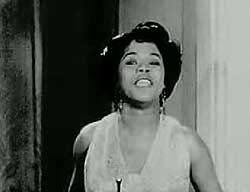 In the 1954 performances Gene Mumford's The Larks were a quartet including David "Boots" Bowers, Orville Brooks & Isaiah Bing. They happened to be in Harlem specifically to do an Apollo Theater show when they got the call asking them if they'd come midtown to sing for a Studio Films project. In the 1954 performances Gene Mumford's The Larks were a quartet including David "Boots" Bowers, Orville Brooks & Isaiah Bing. They happened to be in Harlem specifically to do an Apollo Theater show when they got the call asking them if they'd come midtown to sing for a Studio Films project.
They sang five songs which the producers would pretend were recorded at the Apollo, & these were divided among episodes of the half-hour Live at the Apollo episodes, with the last for the feature-length Rhythm & Blues Revue.
They sang "The World is Waiting for the Sunrise" on the Arthur Godfrey show, & it was expected to gain legs & really sell. The group took turns on leads from song to song; bass singer David McNeil sings the lead on this one. It has an arrangement which the Mills Brothers could've done on live radio in 1932.
Sarah Vaughn whom Willie introduces as "Little Miss Sassy" is next up, in the Snader telescription Perdido (1952). It's a swing number with some strong jazz-vocal moments. Though it's not one of my favorite moments in the film there's no doubt she's a fabulous singer. This & all her other telescriptions are reviewed on the Sarah Vaughan page.
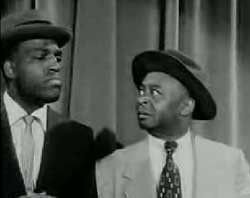 After the Sarah Vaughn short, we return to Willie who does a routine with commedian Nipsy Russell. Nipsy's material with Willie isn't first rate, but he had comic timing & makes more of the material than one would expect.
After the Sarah Vaughn short, we return to Willie who does a routine with commedian Nipsy Russell. Nipsy's material with Willie isn't first rate, but he had comic timing & makes more of the material than one would expect.
Near the end of the film Nipsy will have a second routine alongside Mantan Morland. Some critics now think of Mantan as another Stepin Fetchit whose comedy was at best "problematical." There have even been political analyses that suggests Mantan is the old gard of self-humilitating comics vicariously humiliating all African Americans, whereas Nipsy is representative of the first wave of modern comics who knew better.
This is a great injustice to Mantan who comes a hell of a lot closer to being a character actor & comic of Eddie "Rochester" Anderson's type, not the exaggeratedly stereotyped Stepin Fetchit. Stepin Fetchit is an archetype with nobler origins than might be guessed, but I shan't go into that here, & have to admit he makes me awfully uncomfortable & embarrassed. But Mantan makes me laugh. In fact I love Mantan.
And Nipsy far from being a new kind of comic proudly stands beside Mantan & does one the older comic's classic routines wherein they finish each others' lines. Fact is, though the routine has certainly aged, this is the best piece of comedy among all that was arranged to put between the musical acts, & Mantan merits reevaluation as a fine comic & character actor of yesteryear.
Nipsy also gets to do one of his own stand-up routines. It's all about gambling at the races & being severely assaulted by his wife. It's pretty funny, but that critical assertion that he was a "new" comic no longer dependent on stereotypes certainly isn't proven.
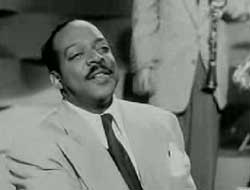 Almost bizarrely, after that first visit from Nipsy, Willie settles down & welcomes us to the show, as though it only just started, rather than this being forty minutes in. It's quite the reminder that this is a patchwork feature. Almost bizarrely, after that first visit from Nipsy, Willie settles down & welcomes us to the show, as though it only just started, rather than this being forty minutes in. It's quite the reminder that this is a patchwork feature.
Of what we've seen up to now (before the arrival of Nipsy & before the Sarah Vaughan telescription), much of it was also released as the half-hour Showtime at the Apollo: Harlem Variety Revue (1955), including the newly filmed Studio telescription segments by Amos Milburn, Bill Bailey, Faye Adams, & The Larks, & the Snader shorts by Lionel Hampton & Herb Jeffries. Plus the mediocre comedy of Freddie & Flo is in that shorter version.
Sarah Vaughn's telescription was part of a different episode, Showtime at the Apollo: Variety Time (1955), as are Cab Calloway's Minnie the Moocher (1950), Ruth Brown's Have a Good Time (1954), Big Joe Turner's Oke-She-Moka-She-Pop (1954), & Lionell Hampton's Cobb's Idea (1951).
Next up in Rythm & Blues Revue is Nipsy Russell opening the show with Willie, then Willie introduces the "first" musical performance, as this one was also used as the opener for Showtime at the Apollo: Stars Over Harlem (1955). It's Count Basie in the Snader telescript film Basie's Conversation (1950), featuring his Septet rather than the orchestra, contrary to Willie's introduction.
Basie mugs with a very pretty face for the camera, & several members of the orchestra get excellent close-up portraits during fine solos.
The primary conversation is between Basie's piano & Jimmy Lewis on bass. But others get to "talk to him!" as one bandmate calls out. In turn the musical talkers are as follows:
Clarinetist Buddy DeFranco, who made Basie's one of the early integrated bands; saxophonist Wardell Gray, who'd met an untimey death under mysterious circumstances just before Rhythm & Blues Revue was released; & trumpeter Terry Clark just before he moved over to Duke Ellington's band.
Also seen in the telescription are Freddie Green on rhythm guitar, & Gus Johnson drumming. Check out more reviews of Basie's soundies & telescriptions.
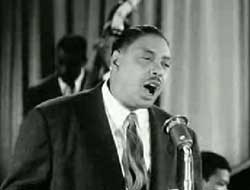 Big Joe Turner follows the Basie telescription, in a freshly filmed performance backed by the Paul Williams band.
Big Joe Turner follows the Basie telescription, in a freshly filmed performance backed by the Paul Williams band.
The Paul Williams Band was truly inspired by Joe's performance & are themselves in top form even before getting to a super sax solo.
Willie had introduced him as "the granddaddy of the blues" but Big Joe's position is really in the transition between jump-jazz (or jump-blues) & rock & roll.
He's more of a rocker than were many of the rockers to come. He's singing his big number Shake Rattle & Roll (1954) that would be covered by dozens of rock bands for years to come.
Watching Joe's performance, it seems kind of amazing that there's so much great stuff in a no-budget film made in great part from pre-existing films.
There's really very little other than the comedy, probably arranged through Willie, that isn't just amazing.
Following Joe Turner there's a Snader telescription for the Delta Rhythm Boys singing Dem Bones (1951) which I reviewed elsewhere, with praise of course.
Another amazing moment comes from an act billed as "Martha Davis & Her Spouse." Big Martha is seated at the piano, & her slim spouse Calvin Ponder is standing with slap bass. Capturing a moment out of their nightclub act, they perform in the Snader telescription Just Goodbye (1951).
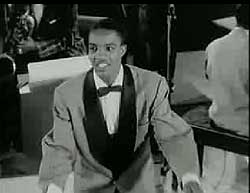 We're now just about to be entertained by a dancer always billed as "Little Buck" because he was a small guy, & young when he started, though calling a black guy "Buck" doesn't set well with everyone, nor should it.
We're now just about to be entertained by a dancer always billed as "Little Buck" because he was a small guy, & young when he started, though calling a black guy "Buck" doesn't set well with everyone, nor should it.
He does a fine tapdance routine with the Paul Williams Band as back-up. I know nothing about Little Buck except that he appeared on the Ed Sullivan Show several times.
He even once appeared on Ed's variety show in a highly acrobatic tap routine with Clayton "Peg Leg" Bates who'd lost a leg in a cotton mill when still a boy but learned to tap better on one leg & a peg than most tapdancers could do on two legs.
Little Buck is clearly a first-rate hoofer, but the age of the tapdancer as superstar had already ended. And despite a couple really flashy moves, he never shows the degree of personality Bill Bailey conveyed in the earlier tap sequence.
Following the newly filmed tap routine, a Snader telescription is spliced in, Nat "King" Cole in Calypso Blues (1951) reviewed elsewhere.
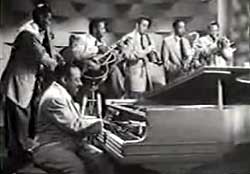 Then Nipsy & Mantan do their comedy routines already discussed above, & the show is winding up with two more Snader telescriptions, including Cab Calloway with his quartet singing Minnie the Moocher (1950) already reviewed. Then Nipsy & Mantan do their comedy routines already discussed above, & the show is winding up with two more Snader telescriptions, including Cab Calloway with his quartet singing Minnie the Moocher (1950) already reviewed.
Last of all is the return of the Count Basie combo to peform One O'Clock Jump (1950), closing the show on the highest note of class.
This is a jump-jazz instrumental & I just love it. In the usual formula, there are solo moments for clarinet, trumpet, saxophone, even Gus on his drum kit & Freddie on rhythm guitar get highlight moments.
What a refined & amazing combo Basie put together, it's just so bizarre to realize they never had a charted hit. Yet being given the closing position for this whole show conveys in just what high esteem he was held as one of the greatest jazz composers.
The two Studio telescriptions by Big Joe Turner & Ruth Brown, together with the older Snaders by Count Basie & Martha Davis, the Delta Rhythm Boys, the added comedy of Mantan & Nipsy, and tapdancer Little Buck, were also sewn together for the half-hour television episode Showtime at the Apollo: Stars Over Harlem (1955). The recycling of overlapping material in three television episodes & one feature film contributed to the legend that it was filmed live at the Apollo rather than patched together from tiny films made over a four year period.
copyright © by Paghat the Ratgirl
|
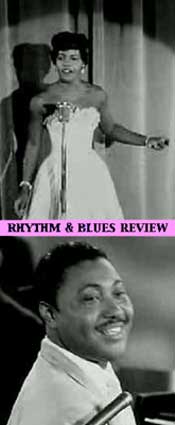



 Hamp's practically soloing on vibrahone, with just the drum & slapbase backing him, with the orchestra otherwise just clapping hands.
Hamp's practically soloing on vibrahone, with just the drum & slapbase backing him, with the orchestra otherwise just clapping hands.
 But there's another version of this telescription in circulation that retains the original 1951 title card & has no audience-reaction intrusions added.
But there's another version of this telescription in circulation that retains the original 1951 title card & has no audience-reaction intrusions added.




 In the 1954 performances Gene Mumford's The Larks were a quartet including David "Boots" Bowers, Orville Brooks & Isaiah Bing. They happened to be in Harlem specifically to do an Apollo Theater show when they got the call asking them if they'd come midtown to sing for a Studio Films project.
In the 1954 performances Gene Mumford's The Larks were a quartet including David "Boots" Bowers, Orville Brooks & Isaiah Bing. They happened to be in Harlem specifically to do an Apollo Theater show when they got the call asking them if they'd come midtown to sing for a Studio Films project.



 Then Nipsy & Mantan do their comedy routines already discussed above, & the show is winding up with two more Snader telescriptions, including Cab Calloway with his quartet singing Minnie the Moocher (1950) already reviewed.
Then Nipsy & Mantan do their comedy routines already discussed above, & the show is winding up with two more Snader telescriptions, including Cab Calloway with his quartet singing Minnie the Moocher (1950) already reviewed.